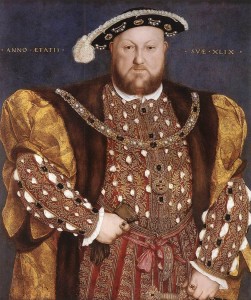 At Whitehall Palace, on 28th January 1547, in the early hours of the morning, a dying Henry VIII squeezed his Archbishop’s hand, giving him the only sign that he could that he trusted in God. He then lapsed into unconsciousness and died. He had reigned for over 37 years and was succeeded by his nine year-old son, Edward VI.
At Whitehall Palace, on 28th January 1547, in the early hours of the morning, a dying Henry VIII squeezed his Archbishop’s hand, giving him the only sign that he could that he trusted in God. He then lapsed into unconsciousness and died. He had reigned for over 37 years and was succeeded by his nine year-old son, Edward VI.
His iconic image, from a lost Holbein mural, is recognised throughout the world and he has gone down in history as the man who had six wives and who executed two of them. He provokes strong feelings and has been labelled a tyrant and monster, but there was more to him than that. In my article “Henry VIII – Henry the Great?”, I quoted David Starkey’s wonderful words about the “two Henrys”, the paradox which is Henry VIII:
“Holbein’s Henry is the king of his last dozen or so years, when he was – in Charles Dickens-s glorious phrase – a spot of blood and grease on the history of England. This is the hulking tyrant with a face like Humpty Dumpty of nightmare, who broke with Rome and made himself supreme head of the church; who married six wives, of whom he divorced two and divorced and executed two others; who dissolved six hundred monasteries; demolished most of them and shattered the religious pieties and practices of a thousand years; who beheaded nobles and ministers, including those who had been his closest friends, castrated, disembowelled and quartered rebels and traitors, boiled poisoners and burned heretics
This is also the king who reinvented England; presided over the remaking of English as a language and literature and began to turn the English Channel into the widest strip of water in the world. He carried the powers of the English monarchy to their peak.”
You can read more about Henry VIII’s achievements and legacy in “Henry VIII – Henry the Great?”.
I will be raising a glass to him today and thinking of the man and his reign.
How can I do that when I believe that he was ultimately responsible for Anne Boleyn’s execution?
Because people are not summed up by one act, however brutal. Too often we think of Henry the tyrant, the man who seemingly entertained Jane Seymour while his wife waited for death, and we forget the charming, intelligent, talented King that Anne Boleyn fell in love with. Whatever your thoughts, he was a fascinating man and I will never bore of reading about him, his wives and his reign. Here’s to Henry VIII!
The King is dead! Long live the King!
You can read more about Henry’s death in the following articles: